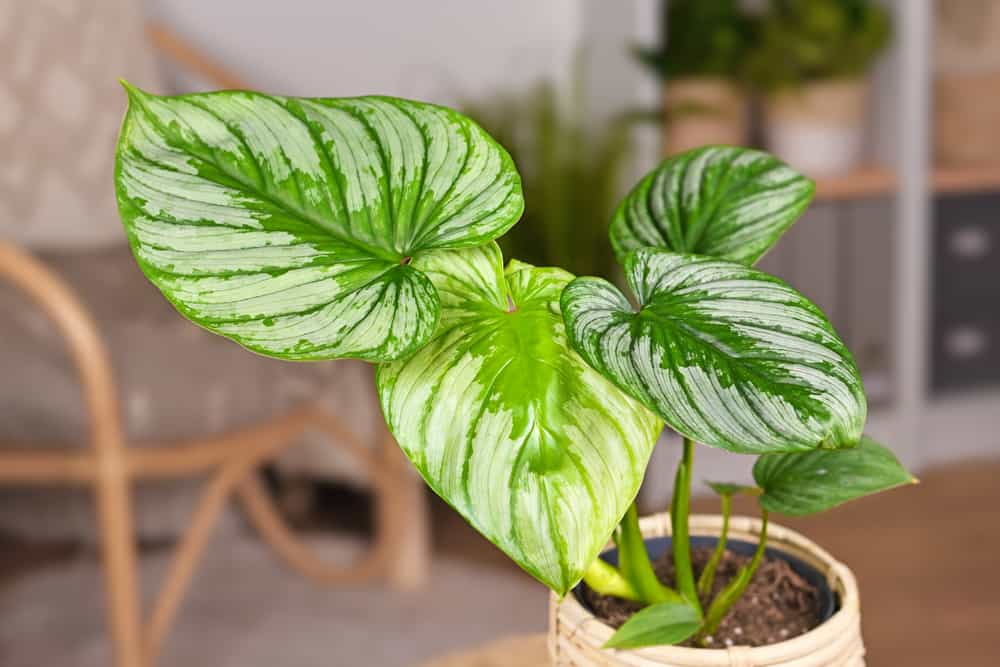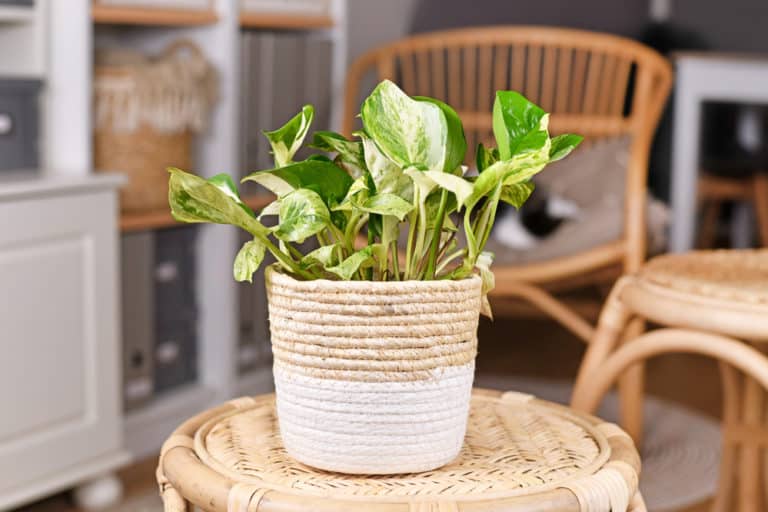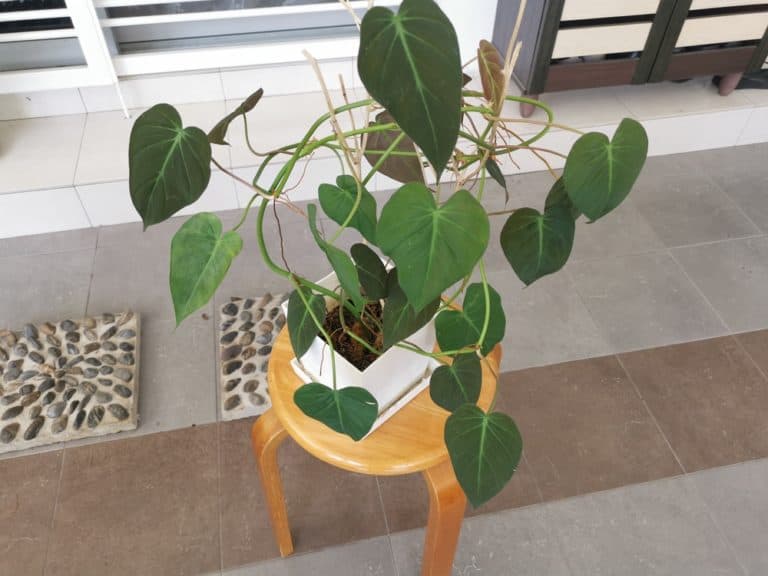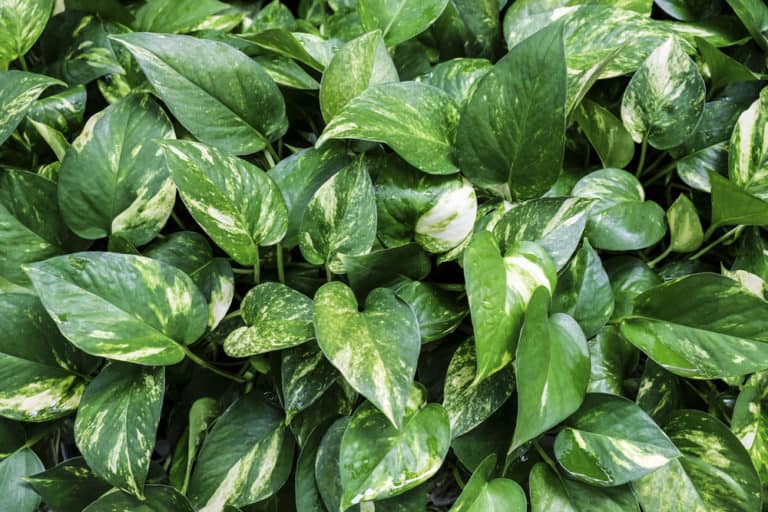Philodendron Mamei ‘Silver Cloud’ Care Guide (2024)

A highly distinguished ornamental plant due to its massive heart-shaped leaves with silvery dust pattern, the Philodendron mamei is a real tropical treat!
Having an epiphytic nature, the plant thrives by creeping on trees and ground. Because of the silver markings found across the leaf blade, the mamei earned the name “Silver Cloud”.
| Scientific Name | Philodendron mamei |
| Common Name | Silver Cloud, Blotched philodendron |
| Light | Bright indirect sunlight |
| Watering | Weekly, water if the top half of soil is dry |
| Temperature | 65°F to 80°F (18°C to 27°C) |
| Hardiness Zone | USDA hardiness zones 9b to 11 |
| Humidity | <60% |
| Soil Type | Rich, quick-draining, high in organic matter (OM) |
| Soil pH | 5.6 and 7.5 (acidic to slightly alkaline) |
| Fertilizing | A balanced feed once a month in spring and summer |
| Repotting | When the size of the plant doubles |
| Pruning | Beginning of the growing season |
| Propagation | Stem cuttings, layering, tissue culture |
| Toxicity | Toxic to humans and pets |
| Mature Size | Can grow up to 3.4 feet |
| Bloom Time | Spring |
What’s Unique About Philodendron mamei?
The Philodendron mamei is native to the rainforests of Ecuador, belonging to the plant family Araceae with over 500 species recorded.
The Philodendron mamei plant is highly distinguished for its massive heart-shaped leaves which have a silvery dust pattern, hence the name silver cloud. The venation runs deep into the leaves, giving off an almost pleated look.
Truly, Philodendron mamei plants are making their way to being the most in-demand decorative houseplant. This is because other than their sophisticated look, they also have an air purifying ability. Considered as beginner friendly, tending to these perennial species is like a walk in the park!
Philodendron mamei Care
The Philodendron mamei plant care involves the use of loose well-draining soil, exposure to bright indirect light, a temperature of at least 80°F (27°C), and a humidity level of 60% or more. The watering cycle is usually once a week and fertilizer may be given once every 4 or 6 weeks. Read on further to be well equipped when it comes to Philodendron mamei care!
Light
Your Philodendron Silver Cloud requires bright indirect sunlight for optimum growth. When grown inside, you can easily meet the Philodendron mamei light requirements by placing it near an east-facing window. This makes the plant receptive to the first soft rays of the sun.
It’s important to note that the plant grows in the understory of taller plants in their native habitat – making them highly adaptable to shaded conditions. It may also be necessary to harden the plant first before taking them out on a permanent location.
Pro tip: In the case of the mamei light needs, filtered sun ensures optimum growth (70-85%). Hence, full sun exposure must be avoided as this scorches the leaves and may later even cause the loss of the silvery patterns.
Watering
As a general rule of thumb, Philodendron mamei watering should be done once a week. It is crucial to keep the soil moist but not waterlogged. It is beneficial to use the appropriate soil mix and a container with sufficient drainage holes. You may reduce watering during winter.
Water mamei when the top inch of the soil feels dry to the touch. Make it a habit to check on the soil and leaves as both give an insight into the watering needs of the plant.
Pro tip: While the Philodendron mamei loves moist soil, it can be quite susceptible to root rot. Avoid this at all costs for this can cause decay of the root system and some parts of the leaves.
Temperature
The Philodendron mamei temperature range lies between 65°F to 80°F (18°C to 27°C). The plant loves warmth conditions but you can attempt to grow the blotched philodendron if your climatic zone has a temperature of around 85°F (29°C) during the day and 59°F (15°C) at night.
Pro tip: Do not let the plant sit at temperatures below 55°F (12.75°C) because the plant does not possess a low-temperature tolerance. Hence, it may be best to bring the plant inside upon arrival of winter to protect it from freezing injury. Moreover, the ideal temperature for mamei is attainable in USDA hardiness zones 9b to 11.
Humidity
Since the plant originates from a very humid environment, you can expect that the Philodendron mamei humidity requirements are quite high, which is at least 60%. Note, however, that the ideal humidity for mamei is usually around 60 to 80%.
Pro tip: If you wish to improve the humidity level inside your home, you can always invest in a humidifier or set up a pebble tray filled with water. It may also be beneficial to mist the plant occasionally. Nevertheless, the silvery cloud plant may still thrive in low humid conditions, but the optimum growth and vibrant foliage development may be attained at 60% humidity and above.
Soil
The Philodendron mamei soil consists of a balanced mix of garden soil, organic matter, and garden compost. A rich but well-draining soil mix is what you’re after. You can always adjust the texture by adding peat, perlite, and orchid bark. Others even add brick bits, coconut husk, and sand. To sum it up, avoid clumpy soil for mamei for this can easily get waterlogged and therefore harm the root system.
Furthermore, the ideal soil ph level for mamei is 5.6 and 7.5 (acidic to slightly alkaline), maintaining this will help sustain plant health status and ensure more vibrant growth and luscious foliage development.
Fertilizer
Your Philodendron mamei fertilizer application may be scheduled every 4 to 6 weeks. Ideally, during spring and summer. You can make use of a balanced fertilizer ratio in liquid form or a slow-release feed every three to six months.
Some growers have also observed that the Silver cloud plant thrives well when raised in soil rich in organic manure. Hence, you can also incorporate other organic amendments like vermicasts and biochar which are well studied to increase beneficial microbial activities in the soil.
Avoid using a cheap fertilizer for mamei as it tends to accumulate in the soil and harms the plant in the long run. Moreover, excessive fertilizer use can affect the appearance of the plant causing leaf curling and pronounced abscission (shedding).
Potting & Repotting
The ideal pot size for Philodendron mamei repotting is 10” by 10” (25 cm in diameter and 25 cm in depth). While they don’t tend to become root bound, they also do not prefer cramped potting, hence, it is recommended that repotting mamei is done once a year or when their size doubles.
When repotting, prepare a fresh potting mix and fill the new container halfway with soil. Providing room for roots is crucial for the plant to optimize its growth. Place the plant in the center and fill in the remaining soil. Water the plant thoroughly and place it under bright indirect light. .
Pruning
Philodendron mamei pruning is an ideal practice to revitalize your plant, particularly when they are suffering from a disease. Cutting mamei to a desirable size may also be convenient, however, it isn’t regularly practiced as it takes time before the plant can heal and attain fuller growth. Hence, the use of foliage-inducing fertilizer is becoming an alternative for encouraging growth and development.
Pro tip: Trim the plant starting from the base and pick only a few stems that can be used later as propagules. When infected with a disease, you may also opt to trim dead and decaying plant portions to prevent further infection.
Propagation
The easiest and perhaps most common method of Philodendron mamei propagation is through the use of stem cuttings.
Do this by selecting stems that have at least one node (the knobby portion where the leaves may be attached). It may also be best to propagate mamei in spring or early summer. You can let the cuttings sit in water where the nodes are fully submerged, making sure that the water is changed regularly, and place them on a spot that receives indirect sunlight.
Other means of propagating this gorgeous specimen are layering (allowing the stem to root while still attached to the mother plant), and tissue culture. These options in plant propagation enable growers to sustain the plant’s availability in the market despite its rarity.
Common Problems of Philodendron mamei
Most Philodendron mamei problems occur due to improper cultural management, for example, sudden wilting and yellowing of the leaves are caused by root rotting which often results from overwatering. A similar symptom may also be accounted for from overfertilization.
Read on further so you can be best equipped in preventing the occurrence of some problems with mamei.
Pests
While the occurrence of Philodendron mamei pests is not entirely problematic, the most common to occur are aphids, moths, fungus gnats, thrips, and mealy bugs. These, however, can be easily removed by spraying or wiping off leaves with rubbing alcohol and running water. You may also use horticultural oils such as neem oil and citronella, which are proven effective to repel insects and thus prevent them from proliferating in the leaves and stems.
Mamei plants are relatively easy to maintain, hence, feeding insects are often not a threat. However, if they occur, you may opt to use more natural methods of managing pests.
Diseases
Root rotting caused by waterlogging can result in numerous types of pathogens that may infect the Mamei plant – causing symptoms such as leaf spots, yellowing, blights, decaying roots and leaves, and stunted growth. Hence, the appropriate watering cycle should be observed.
Nevertheless, Philodendron mamei diseases may also result from the use of contaminated tools such as pruning shears. To prevent this condition, always run a thorough check on your materials and follow proper cultural management. Also, make it a habit to wipe the foliage and prune off spent leaves and stems that may otherwise become an entry point for infections to occur.
Growing Problems
As mentioned above, growing problems of Philodendron mamei are often attributed to improper cultural management. However, given the right information and guidance, tending to a sick plant is no longer as complicated as before.
For example, an infected Silver cloud plant may be easily pruned off with affected parts before resorting to more drastic measures such as the use of fungicides and insecticides.
Moreover, studies indicate that a higher level of humidity and a temperature higher than the optimum encourages bacterial and fungal activities. Hence, growing Philodendron mamei at an ideal temperature and humidity can help prevent the incidence of pests and diseases.
Also, make sure to check out our in-depth Philodendron melanochrysum care guide.
Toxicity of Philodendron mamei
Unfortunately, almost all members of the Philodendron genus have a toxicity level of mild to moderate for cats and dogs. This is because the Mamei plant also contains calcium oxalate crystals which are needle-like compounds that if ingested can cause adverse reactions in the body. Therefore, the silver cloud plant is considered toxic to both humans and animals.
For Humans
Philodendron mamei has a mild to moderate level of toxicity to humans, and small children are the most vulnerable. Calcium oxalate crystals are insoluble and have a needle-like structure that can cause intense pain if they come in contact with the skin or if even ingested. They are found mainly in the leaves of the plant but the stems may also contain them.
If any part of the plant is consumed in large amounts, some of the symptoms may include vomiting, nausea, blisters in the mouth and skin, difficulty in breathing, and difficulty in swallowing. If any of these symptoms occur, you must seek immediate medical attention.
For Pets
If you have a lot of furry friends around the house, it may be safer to place the Silver cloud plant outside. This is because, pets like to nibble on just about anything that they can grasp, and houseplants are no exception. Similar to humans, calcium oxalate crystals can harm the delicate tissues of animals, particularly when ingested in large amounts.
If any symptoms such as diarrhea, urine in blood and stool; pawing of the face; blisters in the mouth; drooling; and restlessness occur, you should immediately bring your pet to the local veterinarian or call the animal poison hotline.
Philodendron mamei Appearance
The Philodendron mamei appearance no doubt contributes to its magnificence. With its massively heart-shaped leaves and silvery dust patterns, this tropical beaut will not only lighten up any dull spaces but will certainly bring that oriental ambiance close to your home. Tackled below are the different features of the plant which you can certainly look forward to!
Foliage
The foliage of the Philodendron mamei is highly distinct due to the large heart-shaped leaves that appear to be almost sprinkled with silvery dust, hence it became remarkably called as “silver cloud’’. The light-colored venation runs deep into the adaxial portion of each leaf which is slightly textured or pleated.
Pro tip: Make it a habit to wipe the leaves of your Philodendron mamei to retain their vibrance. Also, be sure that the mamei plant receives an ample amount of light because any imbalance in this aspect can affect the colors and patterns found in the leaves. By following proper cultural techniques, you can expect a fuller and healthier growth of this stunning specimen.
Flowering
As an aroid plant, the Philodendron mamei flowering occurs as a monocotyledonous inflorescence slightly covered by a spathe and adorned with a spadix. The spadix contains the male and female sterile flowers – in which the latter matures to become receptive to the pollen that will be coming from the male flower. The blooming period usually occurs in spring.
The mamei flower is not considered an important asset of this foliage plant, some would even remove this to concentrate the assimilates to shoot development. Also, floral initials are often disregarded as they may not be a reliable way to propagate the plant compared to stem cuttings or layering.
Size and Growth
The size of Philodendron mamei leaves can go up to 1.5 feet, while the plant, in general, can grow up to 3.4 feet. When provided with the right growing conditions, the plant can expand and cover a diameter of about 5 meters, making them an ideal ground cover.
The plant has a relatively slow growth rate, but it can be prolific when raised in an appropriate environment. Moreover, the use of a balanced fertilizer, particularly during the growing season can also ensure optimum development of the leaves and stems.
Pro tip: Regular pruning of the plant will encourage bushiness and may even provide you with propagules that can later be used for planting.
Philodendron mamei Fragrance
There is little information regarding the Philodendron mamei fragrance. However, a scent is also a good indicator of the health status of your plant. For example, root rotting can cause the release of an unpleasant odor from the base of your Silver cloud plant. If the plant suffers from bacterial infection, affected portions may also emit an obnoxious smell.
Symptoms accompanied by a certain smell signal the presence of either a disease pathogen or a feeding insect. Note that early detection merits an effective treatment. Therefore, it is important to regularly check the leaves, stems, and base of your Silver cloud plant.
Suggested Uses for Philodendron mamei
The Philodendron mamei has more to offer other than its aesthetically pleasing set of foliage. You may also find it a relief that the plant has an air purifying ability, making them an ideal specimen to grow indoors.
According to the NASA clean air study, philodendron species – such as the mamei – are found to be effective in removing the common pollutants found in most homes such as formaldehyde. These attributes give the plant a dual purpose: a decorative houseplant and air filtering specimen.
If grown outside, the silver cloud plant also makes for an ideal ground cover and a design element to fill in empty spaces below the taller garden plants.
FAQ
What is Philodendron mamei?
Philidendron mamei is a tropical perennial plant belonging to the Araceae family found mostly on the ground but sometimes creeps up to trees in search of sunlight.
How to identify Philodendron mamei?
You can easily distinguish the plant through its heart-shaped leaves with silvery dusty markings. The texture of its leaves imitates a less leathery texture compared to other Philos in the market.
How to care for Philodendron mamei?
The Philodendron mamei plant care involves the use of loose well-draining soil, exposure to bright indirect light, a temperature of at least 80°F (27°C), and a humidity level of 60% or more.
How to grow Philodendron mamei indoors?
You can easily meet the Philodendron mamei light requirements by placing the plant near an east-facing window. This makes the plant receptive to the first soft rays of the sun.
How to grow Philodendron mamei outdoors?
Use a well-draining but rich potting mix and a 10’’ by 10’’ pot size. Be sure to move the plant inside when the winter season arrives as they may be susceptible to freezing injury.
How fast does Philodendron mamei grow?
The Philodendron mamei has a relatively slow growth rate. However, given the proper growth condition, the plant may easily expand to 5 meters in diameter.
How tall does Philodendron mamei grow?
The Philodendron mamei can grow up to 3.4 feet and the leaves up to 1.5 feet. Typically grown as ground cover, hence, expect this plant to have a smaller stature.
How to make Philodendron mamei grow faster?
Use a balanced fertilizer ratio – either dry or diluted – can help increase the growth and development of the plant. These may include 10-10-10 NPK or 20-20-20 NPK.
How to stake Philodendron mamei?
Put a stake behind your Philodendron mamei to ensure support. However, if the silver cloud plant is grown as a groundcover, staking is not recommended.
How to pot Philodendron mamei?
Providing room for roots is crucial for the plant to optimize its growth. Prepare a fresh potting soil and container, gently place the plant in the center and fill in the remaining soil. Water as needed.
How to revive Philodendron mamei?
Revive your Philodendron mamei by pruning off the spent leaves and decaying stems. Water appropriately and fertilize the plant as needed or during the growing season.
Why is my Philodendron mamei dying?
Overwatering may cause your Philodendron mamei to suffer from root rot. This may lead to the yellowing of leaves, stunted growth, and eventually to the death of the plant tissue.
Why is my Philodendron mamei drooping?
Overwatering, underwateirng, and nutrient deficiency are among the contributing factors as to why the leaves of your Philodendron mamei are drooping. Investigate the cause and treat accordingly.
How cold can Philodendron mamei tolerate?
Avoid temperatures that go below 55°F (12.75°C), this will make the Philodendron mamei plant susceptible to freezing injury which can later damage the tissues and overall plant system.
How to get rid of pests on Philodendron mamei?
To get rid of pests from your Philodendron mamei, wash the leaves with soap or simply wipe using rubbing alcohol. You can also use horticultural oils such as neem oil and citronella as repellent.
Is Philodendron mamei toxic to cats?
Yes. The Philodendron mamei contains calcium oxalate crystals which can be toxic to cats. Some symptoms that may occur are drooling, restlessness, and blisters in the mouth.
Is Philodendron mamei toxic to dogs?
Yes. The Philodendron mamei contains calcium oxalate crystals which have needle-like structures that can puncture tissues if ingested. Dogs may suffer from blisters and blood may be found in both urine and stool.
Is Philodendron mamei toxic to children?
Yes. The Philodendron mamei is equally toxic to both adults and children. Some of the symptoms that may occur upon ingestion are diarrhea, difficulty breathing, difficulty swallowing, and blisters.
Is Philodendron mamei toxic to humans?
Yes. The Philodendron mamei is found toxic to humans. If any part of the plant is ingested, the symptoms may include vomiting, diarrhea, difficulty breathing, and blisters in the skin and mouth.
Does Philodendron mamei have a scent?
The Philodendron mamei have no distinct scent. However, there are certain smells that can become an indicator of the current health status of your plant.






